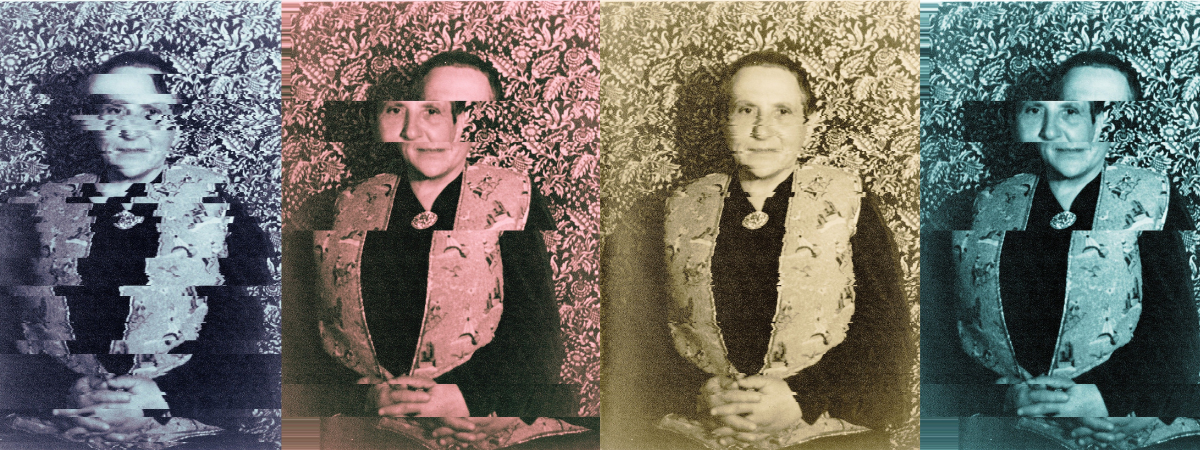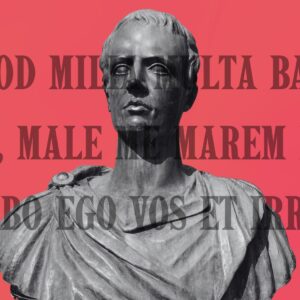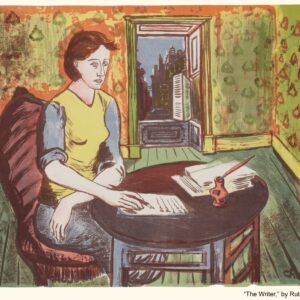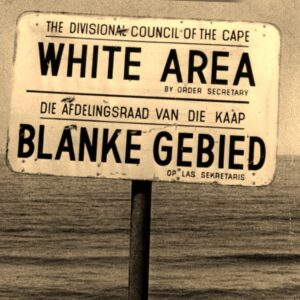
Inventing Gertrude Stein, Literary Cubist
Francesca Wade on the Stylistic Innovations That Made the Expatriate Writer Famous in Her Own Country
Near the beginning of The Making of Americans, Gertrude Stein breaks off abruptly to address her reader—“but truly,” she adds, “I never feel it that there ever can be for me any such a creature, no it is this scribbled and dirty and lined paper that is really to be to me always my receiver.” She knew the novel was long, repetitive, and unwieldy; that it was wholly unlike anything written before. But as the novel progressed, her desire for affirmation only swelled.
Throughout, Stein—or her narrator—contemplates the future of her work. “I write for myself and strangers,” she admits, lamenting the indifference of those around her—thinking, perhaps, of Picasso’s Demoiselles d’Avignon, which still languished in his studio, disdained and unsold. She implores her readers to be patient and eager, to trust her intuition, and follow her in her quest. At this early point, Stein was already setting herself up as a kind of Cassandra, harbinger of a significant message yet doomed to be misunderstood and ignored. “I want readers,” she reiterated, “so strangers must do it.”
In the summer of 1912, Stein and Alice B. Toklas traveled together to Tangier and Spain. It was a period of enormous creativity for Stein, enhanced by the sights and sounds of Spain, the warmth of the people she met—who admired Stein’s cane with its amber head, and speculated that she belonged to a religious order—and her pleasure in Toklas’s company. They adored Ávila, the home of Stein’s favorite saint, Teresa; in Madrid, they discovered Spanish dancing and bullfighting (which Stein watched with relish while Toklas hid her eyes beneath the brim of her flowered hat). Bulls charge into the latter part of A Long Gay Book, blood mingling with rain; in “Susie Asado” and “Preciosilla,” short poems inspired by the whirling skirts of flamenco dancers, Stein’s rhythm accelerates like the clashing of feet and castanets.
In Granada, Stein “worked terrifically” on a flurry of fresh pieces that marked a definitive shift in her style. Up to this point, Stein later recalled, her interest had been primarily in “people, their character, and what went on inside them.” Having moved away from typology, during that Spanish summer she “first felt a desire to express the rhythm of the visible world.”
Stein’s desire to wring every ounce of meaning from a limited set of words transformed into an even bolder ambition: to shed language of all its previous associations.
For the first time, Stein explained, individual words began to feel “more important than the sentence structure or the paragraphs.” Drawing, perhaps, on her neurological research at Johns Hopkins as well as William James’s ideas of thought as a stream of consciousness, Stein was thinking deeply about perception, and the way the brain processes language. She briefly experimented with inventing words, but soon went back to English: Stein was beginning to imagine a kind of writing so original that to read it would almost require a rewiring of the brain’s neural architecture, to unlearn all the ways we expect written language to behave. After The Making of Americans, Stein’s desire to wring every ounce of meaning from a limited set of words transformed into an even bolder ambition: to shed language of all its previous associations, so that her words would mean something fresh and specific, unique to the particular context she was giving them.
In the Autobiography, Stein described this impulse as her “intellectual passion for exactitude,” and linked it to her need to realize a thought perfectly before putting it into writing: “The more exactly the words fit the emotion,” she wrote elsewhere, “the more beautiful the words.” Later, Stein defined this urge as her reaction to the falsity she had begun to see in purely representational art, and the alternative possibilities being put forward by Picasso, who was by now experimenting with geometric compositions (soon to acquire the label “Cubism”) which invite viewers to identify familiar shapes but reject straightforward imitation of the object in favor of fragmentary distortions. “I was alone at this time in understanding him,” Stein wrote later, “perhaps because I was expressing the same thing in literature.” Just as Picasso sought to convey the essence of a person or object without simply creating a replica, Stein wanted her writing to feel not like a description of sounds, colors, or emotions, but an “intellectual re-creation” of the “thing in itself.”
In Spain, Stein began to write a series of short vignettes, each headed with an enigmatic title—“A CARAFE, THAT IS A BLIND GLASS,” “GLAZED GLITTER,” “A SUBSTANCE IN A CUSHION.” By the time she finished, Stein had filled three notebooks, scratching their titles on to the front covers: Objects, Food, Rooms. Within their pages, Stein had created something entirely new. Each word in Tender Buttons—as it came to be called—was recognizable in itself, but here words follow others not to advance any story, but to propel the text forward through verbal echo, surprise, or pure insistence. “Objects” appears, perhaps, to be rooted in a domestic space: a cluttered, dusty but welcoming atelier arranged with bottles, tasseled furnishings, chairs and tables, an inviting closet, boxes stacked in corners, and freshly cut flowers. A reference to “Mildred’s Umbrella” gives a hint at guests, perhaps divested of their hats, canes, and cloaks, sharing coffee and cigarettes and proceeding to the table where “a dinner set of colored china” is laid out for the ensuing feast. “Food” opens with “Roastbeef” and proceeds through a series of luxurious foodstuffs—mutton, rhubarb, asparagus, cream, salmon—though the surreal spread appears to be less for eating than for visual dissection: “Sausages in between a glass,” writes Stein. “Cold coffee with a corn yellow and green mass is a gem.” The final section, “Rooms,” begins with a statement that might be read as Stein’s aesthetic manifesto, following her study of Cézanne: “Act so that there is no use in a center.” Tender Buttons is a celebration of mutability, a rejoinder to rules, where words are set free from the shackles of meaning and grammatical function, made unfamiliar, and charged with power to make the world afresh.
If Tender Buttons has a subject, it lies somewhere in the small sensual pleasures of daily life: the tactility of materials (ribbon, silk, copper), the textures and colors of food, the routines—and erotics—of sharing a home with a partner. “In the inside there is sleeping,” writes Stein in “Food,” “in the outside there is reddening, in the morning there is meaning, in the evening there is feeling.” But the primary pleasure of the text lies in its language. Stein delights in defining things, and posing questions that cannot be answered because their component words bear little obvious relation to one another—“Why is a feel oyster an egg stir,” she writes. “Why is it orange center.” She attempted to empty her mind of what she called “associational emotion”—the meaning a word conventionally bears, which holds within it a memory of all the previous times it has been used in that way. “I took individual words and thought about them until I got their weight and volume complete and put them next to another word,” Stein told an interviewer in 1946, “and at this same time I found out very soon that there is no such thing as putting them together without sense.”
Stein had come to see words as living entities with physical properties of their own, like the materials a painter or sculptor might take on and shape into something new, or the neurons in the brain, processing information and connecting with one another through synapses. “Writing,” she wrote, “may be made between the ear and the eye”: now, her inspiration tended to come not from the external world, but from the sounds and shapes of words themselves. “Give known or pin ware,” opens a text titled “Guillaume Apollinaire,” Stein sounding the syllables in her mouth and remaking her friend’s name into something else—almost translating the French words into English, matching them to equivalents not by meaning but by sound.
“Susie Asado” borrowed the Spanish word asado, meaning “roasted,” which rhymes with helado, ice cream; the enigmatic final line of its companion portrait, “Preciosilla”—“Toasted susie is my ice-cream”—shows Stein reveling in the possibilities of her own multi-lingual puns, recycling and reanimating the earlier text, imbuing it with erotic delight. As Stein’s words are loosened from association with one another, they brighten a little in themselves; they arrest both eye and ear as the reader is forced to pause on them, look and listen, rather than fit them automatically into a sentence. There’s no discernible narrator in these texts, as there was in The Making of Americans, yet Stein is present in every sentence, forming and re-forming language, and celebrating the space and love she was sharing, now, with Toklas.
*
Stein’s appearance in Camera Work had drawn the attention of a woman whose Greenwich Village parties offered bohemian New York a gathering place akin in spirit to the Rue de Fleurus, with the Steins’ austerity replaced by lavish quantities of Scotch, bowls full of cigarettes, and trays mounted with piles of ham and Gorgonzola sandwiches. Like Gertrude Stein, Mabel Dodge sought to make her life a work of art: she surrounded herself with writers and artists, whom she gathered at her Fifth Avenue apartment and at the Villa Curonia, her fifteenth-century palazzo outside Florence. A mutual friend brought Dodge to a Saturday evening salon while she was visiting Paris, and the pair immediately hit it off, Stein eager for enthusiastic readers and practical help with publishers, Dodge seeking to ally herself with the newest ideas that crossed her path. Stein showed Dodge the latest version of The Making of Americans, and was immensely gratified when Dodge responded (despite having nearly lost the entire manuscript after dropping it on a train platform) that it was “one of the most remarkable things I have ever read.” “It is as new & strange & big as the post-impressionists in their way,” she wrote. “I am perfectly convinced, it is the forerunner of a whole epoch of new form & expression. It is very morally constructive for I feel it will alter reality as we have known it.”
In the autumn of 1912, shortly after their return from Spain, Stein and Toklas visited Dodge at the Villa Curonia. Stein was still grappling with the ideas unlocked by Tender Buttons, and had returned to portraiture with new energy. Dodge had already poured out her heart in letters to Stein, expressing her dissatisfaction with her husband and her passion for her son’s handsome young tutor. Stein’s bedroom adjoined the room where Dodge would visit her lover at night; kept awake by the murmurings and moans, Stein lit a candle and composed a portrait of her host. Dodge was thrilled, and immediately had 300 copies printed and covered in Florentine wallpaper, which she placed on a table in her hallway for guests to take. Back in America, she reported her friends’ (often bewildered) reactions to “The Portrait of Mabel Dodge at the Villa Curonia,” and urged Stein to visit New York: “On account of my judicious scattering of the Portrait,” wrote Dodge, “everyone is saying ‘Who is Gertrude Stein? Who is Mabel Dodge at the Villa Curonia.’ ”
Dodge’s flattery was certainly self-serving—the connection of their names through the portrait meant she was well positioned to bask in Stein’s reflected glory—but she operated shrewdly to build Stein up as the literary counterpart to the new, nonrepresentational, Post-Impressionist art. At the start of 1913, New York was consumed with preparations for the Armory Show, which Dodge described to Stein as “the most important public event that has ever come off since the signing of the Declaration of Independence.”
Among the 1,300 works brought over for the exhibition, which was conceived in order to introduce American audiences to the modern art being made in Europe, was a roster of loans from 27 Rue de Fleurus, including Matisse’s Blue Nude and two Picasso still lifes. Dodge—who joined the organizing committee a few weeks before the opening, and instantly started to call it “my own little Revolution”—told Stein she had been raving to the organizers about her friend’s work, and that she intended to write an article about Stein and Picasso for Arts and Decoration magazine, which was devoting its entire March 1913 issue to the show. Although she admitted her interpretation might be “not at all what you mean,” “it will,” Dodge gleefully wrote, “make your name known by & large—as the writer of ‘post impressionistic literature’…So there Gertrude is my confession. I am your faithful & incomprehending Boswell.”
Stein, for now, was happy to accept Dodge’s enthusiasm. After the success of Three Lives, she was hungry for more attention. “You have made an audience for me alright, it’s been a real triumph. I can’t thank you enough,” wrote Stein to Dodge. The article—Stein’s most significant piece of publicity yet—conjured a vibrant picture of the Stein salon, and made the case that Stein “is doing with words what Picasso is doing with paint. She is impelling language to induce new states of consciousness.” After it came out, Dodge wrote triumphantly to Stein, claiming magazine editors were flocking to her asking for examples of Stein’s work to publish, and that she was demanding Stein be paid for every opportunity. No chances were taken: she sent a lawyer round to visit a publisher who held on too long to a manuscript, and insisted, on Stein’s stipulation, that any contract signed should contain a bankruptcy clause to prevent the copyright going to creditors if the company went bust. One friend, she boasted, had just declared that “the name of Gertrude Stein is better known in New York today than the name of God.” Stein replied, “Hurrah for gloire.”
In Paris, friends were bemused at the turn Stein’s work had taken, and at New York’s alleged appetite for what seemed to many like incomprehensible jumbles of words. Leo called the “Portrait of Mabel Dodge” “damned nonsense,” while Mary Berenson sent her family a copy of “Gertrude Stein’s latest amazing (and horrid) production,” expressing wonder that “many people take it seriously as a new worthwhile ‘departure.’ It isn’t even funny, only horrible.” But insulated by support and encouragement from Toklas and Dodge, Stein was able to ignore dissenting voices and focus on her work. She asked the American friends— including May Knoblauch—who had copies of her manuscripts to send everything to Dodge, so she could henceforth field all inquiries for Stein’s work. “I am working like a dog over you,” Dodge told her. “It has to be done subtly. I have made all NY as well as suburbs talk about you. Now is the time for the publishers & they know it.” “It takes lots of shoving to make them take me,” Stein replied matter-of-factly, “but I guess you will do it.” But Dodge’s position as Stein’s exclusive representative was shortly to be superseded.
On February 24, 1913, Dodge sent Stein a short article in the New York Times under the headline “Cubist of Letters”—unsigned, and inexplicably published only in the financial section of the paper’s early edition, but written at Dodge’s encouragement by a new friend of hers, a young dance critic making his name as a champion of the avant-garde. “This is post-impressionist, or cubist, or futurist literature…a new attempt at feeling a thing,” he wrote, quoting an unnamed friend—Dodge— who had declared that Stein’s writing “demands an entirely new point of view.” Stein was delighted with the publicity, and intrigued when its author, Carl Van Vechten, wrote beguilingly to tell her his original article was “three times as long and four times as amusing,” and to ask if she would meet him in Paris that June. “He wants me to tell him about myself,” she told Dodge. “I hope I will be satisfactory.”
Like Stein, Van Vechten knew the value in self-mythologizing, and like Dodge, he saw the advantages of yoking his own name to Stein’s fast-growing legend. Their first meeting was a hit. Van Vechten reported to his wife that Stein was “a wonderful personality…She lives in a place hung with Picassos and she showed me some more sketches of his including men with erect Tom-Toms much bigger than mine.” In later years, he claimed that they had met in a box at the premiere of Stravinsky’s Rite of Spring, where riots broke out among the audience appalled at the discordant music. It was a sly elision of the truth which placed the two of them together at one of the most notorious moments in avant-garde history. In fact, they had attended the second performance, but—as Van Vechten cheerfully wrote to Stein—“one must only be accurate about such details in a work of fiction.”
Six years younger than Stein, Van Vechten was eager to ally himself with anything that seemed to upend tradition: his debut as an arts critic was a glowing review of Strauss’s adaptation of Salome, notorious for a nine-minute-long striptease, and he was one of the first to praise Isadora Duncan’s fluid dance movements. And he had connections at many of the leading small magazines, where Stein most wanted her work to appear. As their correspondence continued, Stein began to sound out Van Vechten about the possibility of finding an audience for Tender Buttons. “I tried to get a combination of sound and picture that would make the effect,” she told him. “I worked over them awfully hard, and I think I succeeded.”
Van Vechten complimented Tender Buttons lavishly, and swiftly obtained an offer of publication from his friend Donald Evans, a dandyish poet who had founded Claire Marie Press to print what he called “New Books for Exotic Tastes.” Stein was enthusiastic, but Dodge—sensing that her grip on Stein’s image was slipping—wrote to express her concern at the choice of press, which she considered “absolutely third-rate.” The association, she argued, risked the public inferring “that there is something degenerate & effete & decadent about the whole of the cubist movement which they all connect you with.”
When Stein didn’t change her mind, Dodge wrote again, with renewed desperation: “I really believe you will give your work a set back and make further publishing & understanding of it more difficult unless you withdraw what he has from D. Evans.” But Stein remained resolute: the contract was signed in March 1914, and she asked Dodge to return the short pieces in her possession. Dodge attempted to keep their correspondence up, but Stein’s replies grew more and more infrequent, and further invitations to the Villa Curonia were coldly refused.
The publication of Tender Buttons, in May 1914, sparked debates across America. “Officer, She Is Writing Again,” announced Detroit News. The Pittsburgh Dispatch denounced it as “a scramble of meaningless words” from a writer, nonetheless, who appeared to be “the most talked-about creature in the intellectual world today”; the Boston Evening Transcript lampooned a library for classifying Tender Buttons under “literature”; while one critic claimed that three typesetters had quit their jobs rather than attempt to set the text, which “can be read either backward or forward, for it produces the same impression either way.”
Evans was delighted to trade on Stein’s controversy, describing Tender Buttons in his press release as “one of the most unique books of the twentieth century” and Stein “the patron saint of the new artists.” Whether or not the work was genius, mad or a hoax, he declined to confirm: “It is idle to attempt to pass judgment at the present moment. Time alone can give the verdict. For us it is merely that she is a real force that must be reckoned with—she cannot be ignored…The effect produced on the first reading is something like terror.”
Stein had come to see words as living entities with physical properties of their own, like the materials a painter or sculptor might take on and shape into something new.
Whether ecstatic or vitriolic, the attention the book garnered was unprecedented. Newspapers, both local and national, devoted not just reviews but columns and opinion pieces to Stein and Tender Buttons. Those who praised the book—or at least sought to appraise it on its own terms—claimed Stein had found “an entirely new use for words,” only to be accused of posturing, in a pathetic attempt to demonstrate pseudo-sophistication. The well-known humorist and poet Don Marquis started to quote lines from Tender Buttons as a running gag in his New York Evening Sun column, while the Chicago Tribune invited readers of “extreme Cubist literature” to send in their own attempts at “futurist poetry,” urging them first to “use a vacuum cleaner on your brain.”
One commentator spoke for many when he noted that the scale of discourse had long since transcended the question of Stein’s actual merits (and that far more people were opining on the book than could actually have read it, given its limited print run): “It will not do to say that nobody takes her seriously; newspapers do, or they would not give up so much space to her.” As the poet Alfred Kreymborg put it, “Gertrude Stein has provided the world with a new kind of entertainment.” Whether you defended or attacked or simply laughed at her, he wrote, “Miss Stein will have benefited you. She has given you a new sensation.”
Van Vechten saw his moment to assert his status as Stein’s primary promoter and interpreter. He set out his position in an article in The Trend magazine of August 1914, titled “How to Read Gertrude Stein.” “Miss Stein has no explanations to offer regarding her work,” he informed his readers. “I have often questioned her, but I have met with no satisfaction. She asks you to read.” He painted a colorful picture of a mysterious eccentric, “massive in physique,” who stalked Paris in brown velvet robes and carpet slippers and wrote by night. Stein, he explained, had taken on English, a language “of hypocrisy and evasion,” and “turned language into music, really made its sound more important than its sense.” To Mabel Dodge, Van Vechten’s article, coupled with Stein’s ongoing silence, made clear that she had been supplanted. When Dodge complained to Leo Stein that his sister had cut her off without a word of explanation, he speculated that Gertrude felt threatened by the publicity Dodge herself garnered from the connection: “There was a doubt in her mind,” Dodge remembered Leo telling her, “about who was the bear and who was leading the bear.” But by this time, Leo, too, had ceased to be his sister’s confidant.
The three of them—Toklas and the two Steins—had lived uneasily together since 1910. Leo had long since retreated from the regular Saturday nights: when Stein and Toklas visited London early in 1913, on a trip Stein called their honeymoon, he refused even to open the door to expectant visitors. He was preoccupied with two matters: his diet, and his girlfriend. When Toklas joined the household, Leo was engulfed in what he called a “perfect whirlpool of tragicomic romance”: an on-again-off-again relationship with Nina Auzias, a singer and life model whom he had met at a party and immediately asked to pose for him nude.
In February 1910, Leo reported that Nina had several men desperate to marry her, all threatening to kill themselves and each other if she didn’t choose them. Gertrude disapproved of Nina: her portrait “Elise Surville” portrayed her would-be sister-in-law as a prostitute, selling her wares sur ville, a clear reference to Paris’s red light district. As his relationship faltered, Leo had become possessed with faddish diets; he began with Fletcherism—chewing food thoroughly to optimize digestion—and soon was fasting for twenty or thirty days at a time, which left him weak and practically delirious. Gertrude watched her brother alienate his friends, sapped of mental energy, and increasingly cantankerous. Worst of all, he thought her work was ridiculous, and said so. Cubism, he insisted, was “tommyrot…whether in paint or ink”; he added, crankily, that he supposed his opinion counted for nothing since he was a “rank outsider…no longer a prophet.”
On February 7, 1913, Leo Stein had written to their mutual friend Mabel Weeks that “one of the greatest changes that has become decisive in recent times is the fairly definite ‘disaggregation’ of Gertrude and myself.” “The presence of Alice was a godsend,” he continued, “as it enabled the thing to happen without any explosion. As we have come to maturity, we have come to find that there is practically nothing under the heavens that we don’t either disagree about, or at least regard with different sympathies.” That spring, he left Paris for Florence. He told Weeks how relieved he was to have moved out: that his health and memory were improving, he was beginning to unravel “impenetrable mysteries” of mathematics, and was very happy living simply, eating just bread and fruit, and seeing nobody.
In The Autobiography of Alice B. Toklas, Stein elided the emotional import of Leo’s departure, focusing only on practical matters: “During the winter Gertrude Stein’s brother decided that he would go to Florence to live. They divided the pictures that they had bought together, between them.” Gertrude had the paintings appraised by Picasso’s dealer Daniel-Henry Kahnweiler, who estimated the value of the collection at 158,550 francs. She took possession of all the Picassos (she sold three to Kahnweiler for 20,000 francs and a new painting), while Leo left with all the Matisses, with the exception of the Femme au Chapeau. Leo wrote from Florence to remind Gertrude, who had evidently challenged his right to a Cézanne painting of apples, that he had paid a “grossly disproportionate” share of the household expenses, and that the apples were irreplaceable for him. “I hope that we will all live happily ever after,” he concluded, “sucking gleefully our respective oranges.”
In her autobiography, Mabel Dodge laid the blame for her schism with Stein firmly on one person. The split, she declared, was “Alice’s final and successful effort in turning Gertrude from me.” From her first visit to the Rue de Fleurus, Dodge had considered Toklas a malevolent presence in the household. She had made herself indispensable, Dodge thought, by doing “everything to save Gertrude a movement…and Gertrude was growing helpless and foolish from it and less and less inclined to do anything herself.” Dodge assumed that insecurity was Toklas’s motive for insisting Stein cease contact: she claimed to have felt an attraction from Stein—“such a strong look over the table that it seemed to cut across the air to me in a band of electrified steel”—which had ignited Toklas’s jealousy. Toklas appeared, Dodge wrote, to be “so self-obliterating that no one considered her very much beyond thinking her a silent, picturesque object in the background, but lo and behold, she pushed Leo out quite soon.”
Leo’s assessment of Toklas was no more positive. “She’s a sort of all-important second fiddle,” he raged in a letter to Mabel Weeks, “a kind of abnormal vampire who gives more than she takes.” In the summer of 1913, Carl Van Vechten met Leo at the Villa Curonia, and recorded in his diary that Leo said he had told Gertrude “that any manifestation of homosexuality of any kind annoyed him and he asked them to refrain…as they were accustomed to being rather careless in their affection before him.” Leo had also, apparently, told the gathered group that Toklas was “a stupid girl” and that “some day she will do harm to Gertrude”: “It sickened me,” Leo concluded, “to see the weaker nature getting the better of the stronger.” Van Vechten, when he came to know Stein and Toklas better, came to agree superficially with these interpretations of their interdependence: Stein, he admitted, could not “cook an egg, or sew a button, or even place a postage stamp of the correct denomination on an envelope.”
But Van Vechten saw what the others did not: that Toklas’s devotion created the conditions essential for Stein’s writing. Now, visitors to the Rue de Fleurus would see that Leo’s old door was plastered up, and Picasso’s portrait of Gertrude had taken center stage above her chair. No longer was this the shared salon of Leo Stein and his eccentric sister: this was the home, and the workplace, of the internationally renowned writer Gertrude Stein and Alice B. Toklas, her secretary and wife.
__________________________________

Excerpted from Gertrude Stein: An Afterlife by Francesca Wade. Copyright © 2025 by Francesca Wade. Reprinted by permission of Scribner, an imprint of Simon & Schuster, LLC.
Francesca Wade
Francesca Wade is the author of Square Haunting: Five Writers in London Between the Wars (2020). She has received fellowships from the Dorothy and Lewis B. Cullman Center, the Leon Levy Center for Biography and the Harvard Radcliffe Institute, and her writing has appeared in The New York Review of Books, London Review of Books, Paris Review, Granta, and elsewhere.












